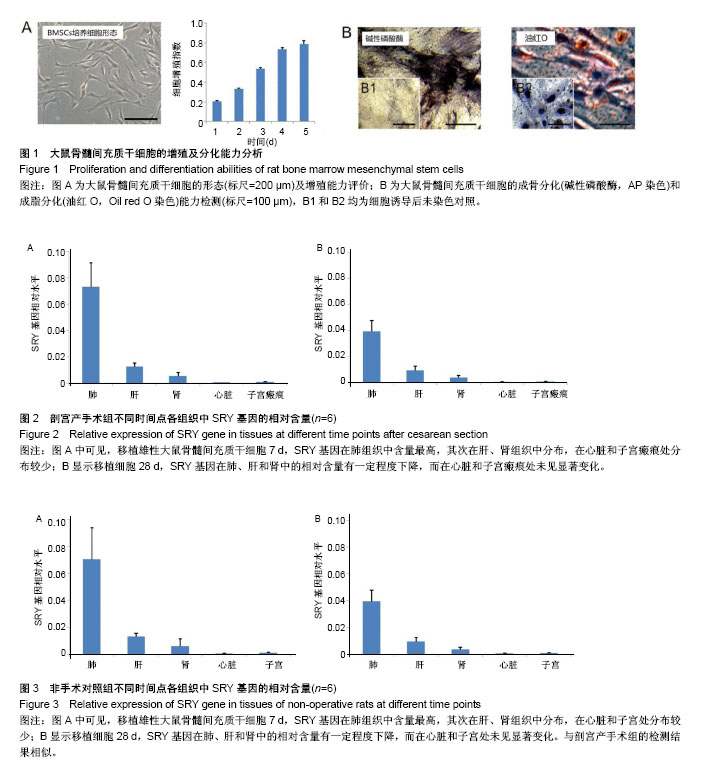| [1] Lumbiganon P, Laopaiboon M, Gülmezoglu AM,et al.Method of delivery and pregnancy outcomes in Asia: the WHO global survey on maternal and perinatal health 2007-08.Lancet. 2010;375(9713):490-499. [2] 程蔚蔚,朱关珍.剖宫产的近期和远期并发症[J].中国实用妇科与产科杂志, 2003,19(7):442-444.[3] Roberge S, Demers S, Berghella V,et al.Impact of single- vs double-layer closure on adverse outcomes and uterine scar defect: a systematic review and metaanalysis.Am J Obstet Gynecol. 2014;211(5):453-460. [4] Fukuchi Y, Nakajima H, Sugiyama D, et al. Human placenta-derived cells have mesenchymal stem/progenitor cell potential.Stem Cells. 2004;22(5):649-658.[5] Pittenger MF, Mackay AM, Beck SC et al. Multilineage potential of adult human mesenchymal stem cells. Science. 1999;284(5411):143-147.[6] Baksh D, Yao R, Tuan RS. Comparison of proliferative and multilineage differentiation potential of human mesenchymal stem cells derived from umbilical cord and bone marrow. Stem Cells. 2007;25(6):1384-1392. [7] Campagnoli C, Roberts IA, Kumar S,et al. Identification of mesenchymal stem/progenitor cells in human first trimester fetal blood, liver, and bone marrow. Blood. 2001;98(8): 2396-2402. [8] Kinnaird T, Stabile E, Burnett MS,et al.Marrow-derived stromal cells express genes encoding a broad spectrum of arteriogenic cytokines and promote in vitro and in vivo arteriogenesis through paracrine mechanisms.Circ Res. 2004; 94(5):678-685.[9] Williams AR, Hare JM. Mesenchymal Stem Cells: Biology, Pathophysiology, Translational Findings, and Therapeutic Implications for Cardiac Disease. Circ Res. 2011;109(8): 923-940[10] Haleem AM, Singergy AA, Sabry D,et al.The Clinical Use of Human Culture-Expanded Autologous Bone Marrow Mesenchymal Stem Cells Transplanted on Platelet-Rich Fibrin Glue in the Treatment of Articular Cartilage Defects: A Pilot Study and Preliminary Results.Cartilage. 2010;1(4): 253-261.[11] Tang Y, Cai B, Yuan F, et al. Melatonin pretreatment improves the survival and function of transplanted mesenchymal stem cells after focal cerebral ischemia. Cell Transplant.2013; 23(10):1279-1291.[12] Jin Y, Bouyer J, Shumsky JS,et al. Transplantation of neural progenitor cells in chronic spinal cord injury.Neuroscience. 2016;320:69-82.[13] Mathiasen AB,Qayyum AA, Jorgensen E,et al.Bone marrow derived mesenchymal stromal cell treatment in patients with severe ischaemic heart failure: a randomized placebo- controlled trial(MSC-HF trial).Eur Heart J.2015; 36(27): 1744-1753.[14] Jayaraman P, Nathan P, Vasanthan P, et al. Stem cells conditioned medium: a new approach to skin wound healing management. Cell Biol Int.2013;37(10):1122-1128. [15] Patel DM, Shah J, Srivastava AS. Therapeutic potential of mesenchymal stem cells in regenerative medicine. Stem Cells Int.2013;2013:496218.[16] Shabbir A, Cox A, Rodriguez-Menocal L, et al. Mesenchymal Stem Cell Exosomes Induce Proliferation and Migration of Normal and Chronic Wound Fibroblasts, and Enhance Angiogenesis In Vitro. Stem Cells Dev. 2016;24(14): 1635-1647.[17] Wang Y, Chen X, Cao W, et al. Plasticity of mesenchymalstem cells in immunomodulation: pathological and therapeuticimplications. Nat Immunol. 2014;15(11): 1009-1016.[18] Hashemian SJ, Kouhnavard M, Nasli-Esfahani E.Mesenchymal stem cells: rising concerns over theirapplication in treatment of type one diabetes mellitus. J Diabetes Res. 2015;1:1-19 [19] 高杰清,谢宗燕,母义明,等.脐带间充质干细胞在2型糖尿病大鼠中的疗效及作用机制[J].中华内分泌代谢杂志, 2017,33(1): 62-67.[20] Saito Y, Shimada M, Utsunomiya T,et al.Homing effect of adipose-derived stem cells to the injured liver: the shift of stromal cell-derived factor 1 expressions.J Hepatobiliary Pancreat Sci. 2014;21(12):873-880. [21] 邓蓉蓉,谢伊旻,谢林.间充质干细胞归巢的研究与进展[J].中国组织工程研究,2016,10(19):2879-2888.[22] Ringe J, Strassburg S, Neumann K, et al. Towards insitu tissue repair: human mesenchymal stem cellsexpress chemokine receptors CXCR1, CXCR2 andCCR2, and migrate upon stimulation with CXCL8 butnot CCL2. J Cell Biochem. 2007;101(1):135-146.[23] Weeks S,Kulkarni A,Smith H,et al. The effects of chemokine, adhesion and extracellular matrix molecules on binding of mesenchymal stromal cells to poly( l -lactic acid). Cytotherapy. 2012;14(9):1080-1088.[24] 程斌,方驰华,范应方,等.骨髓间充质干细胞提取方法的改良[J].中国组织工程研究与临床康复, 2008,12(47):9293-9296.[25] Karp JM, Leng Teo GS. Mesenchymal stem cellhoming: the devil is in the details. Cell Stem Cell.2009;4(3):206-216.[26] Cheng K, Rai P, Plagov A,et al.Transplantation of bone marrow-derived MSCs improves cisplatinum-induced renal injury through paracrine mechanisms.Exp Mol Pathol. 2013; 94(3):466-473.[27] Gao J, Dennis JE, Muzic RF, et al. The dynamic in vivodistribution of bone marrow-drived mesenehymal stem cellsafter infusion. Cells Tissues Organs. 2001;169(1):12-20.[28] Liu J, Wang H, Li J.Inflammation and Inflammatory Cells in Myocardial Infarction and Reperfusion Injury: A Double-Edged Sword.Clin Med Insights Cardiol. 2016;10:79-84. [29] Halabian R, Tehrani HA, Jahanian-Najafabadi A, et al. Lipocalin-2-mediated upregulation of various antioxidants and growth factors protects bone marrow-derived mesenchymal stem cells against unfavorable microenvironments.Cell Stress Chaperones. 2013;18(6):785-800.[30] Siao CJ,Lorentz CU,Kermani P,et al.ProNGF,a cytokine induced after myocardial infarction in humans,targets pericytesto promote microvascular damage and activation.J Exp Med. 2012;209(12):2291-2305. [31] 张静,魏峰,吴忠东,等.同种异体骨髓间充质于细胞在大鼠体内心肌缺血微环境中的分化及存活[J].安徽医科大学学报, 2014, 49(3):300-303. [32] LV di Bonzo LV, Ferrero I, Cravanzola C, et al. Human mesenchymal stem cells as a two-edged sword in hepatic regenerative medicine: engraftment andhepatocyte differentiation versus profibrogenic potential. Gut. 2008; 57(2):223-231.[33] 何秀华,李东良,江军,等.移植途径对大鼠骨髓间充质干细胞归巢及肝功能恢复的影响[J].中华细胞与干细胞杂志:电子版, 2011, 1(1): 57-62. |
.jpg)

.jpg)